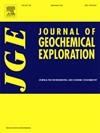Geostatistical modelling of mine tailings and comparative analysis of sampling methodologies: A case study of the Otanmäki ilmenite tailings storage facility project
IF 3.3
2区 地球科学
Q1 GEOCHEMISTRY & GEOPHYSICS
引用次数: 0
Abstract
Increasing concerns about the availability of Critical Raw Materials (CRMs) have shifted focus to extractive waste sites as potential sources for secondary resources. Resource assessment requires robust investigation and resource definition, necessitating representative sampling and use of an appropriate modelling method. In this study, spatial sampling sensitivity was tested at the Otanmäki tailings storage facility (TSF) by conducting multiple models at different scales, utilizing both previously collected and new data. Additionally, three tailings sampling methodologies were evaluated to ensure sample representativity and minimize contamination: a tube sampler with a valve, a flow-through blade, and an auger drill.
Results indicated that both the auger drill and the tube sampler perform well and provide similar results under low moisture conditions. However, the tube sampler was estimated to be more accurate in varying conditions, despite it having a smaller sample volume and being more time-consuming to use. According to the modelling results, there were minimal changes in grade and tonnage when increasing sampling density or changes in model scale. Thus, the existing resource estimation from the Otanmäki TSF that was based on a 100 × 100 m grid could be considered as having a high-confidence in relation to the G-category in the United Nations Framework Classification for Resources (UNFC) system with effective investigation of tailings sites requires a tailored approach considering factors such as ore deposit type, mineralization style, and information on ore processing and tailings disposal practices. This work provides insights into tailings resource modelling, estimation confidence, sample representativity, and optimal sampling strategies, aiding in the resource classification of tailings sites.
矿山尾矿地质统计建模与抽样方法对比分析——以Otanmäki钛铁矿尾矿储存设施项目为例
对关键原材料(CRMs)可用性的日益关注已将焦点转移到采掘废物场地作为二次资源的潜在来源。资源评估需要强有力的调查和资源定义,需要有代表性的抽样和使用适当的建模方法。本研究在Otanmäki尾矿储存库(TSF)进行了空间采样灵敏度测试,利用之前收集的数据和新收集的数据,在不同尺度下建立了多个模型。此外,还评估了三种尾矿取样方法,以确保样品的代表性并最大限度地减少污染:带阀的管式取样器、流经刀片和螺旋钻。结果表明,螺旋钻和管式取样器在低湿度条件下均表现良好,且结果相似。然而,管式取样器估计在不同的条件下更准确,尽管它具有较小的样本量和更耗时的使用。根据模型结果,当增加采样密度或改变模型比例尺时,等级和吨位的变化很小。因此,现有的基于100 × 100米网格的Otanmäki TSF资源估计可以认为与联合国资源框架分类系统(UNFC)中的g类相比具有高置信度,对尾矿场址进行了有效的调查,需要考虑到矿床类型、矿化风格以及有关矿石加工和尾矿处置做法的信息等因素,采用量身定制的方法。这项工作为尾矿资源建模、估计置信度、样本代表性和最佳采样策略提供了见解,有助于尾矿场地的资源分类。
本文章由计算机程序翻译,如有差异,请以英文原文为准。
求助全文
约1分钟内获得全文
求助全文
来源期刊

Journal of Geochemical Exploration
地学-地球化学与地球物理
CiteScore
7.40
自引率
7.70%
发文量
148
审稿时长
8.1 months
期刊介绍:
Journal of Geochemical Exploration is mostly dedicated to publication of original studies in exploration and environmental geochemistry and related topics.
Contributions considered of prevalent interest for the journal include researches based on the application of innovative methods to:
define the genesis and the evolution of mineral deposits including transfer of elements in large-scale mineralized areas.
analyze complex systems at the boundaries between bio-geochemistry, metal transport and mineral accumulation.
evaluate effects of historical mining activities on the surface environment.
trace pollutant sources and define their fate and transport models in the near-surface and surface environments involving solid, fluid and aerial matrices.
assess and quantify natural and technogenic radioactivity in the environment.
determine geochemical anomalies and set baseline reference values using compositional data analysis, multivariate statistics and geo-spatial analysis.
assess the impacts of anthropogenic contamination on ecosystems and human health at local and regional scale to prioritize and classify risks through deterministic and stochastic approaches.
Papers dedicated to the presentation of newly developed methods in analytical geochemistry to be applied in the field or in laboratory are also within the topics of interest for the journal.
 求助内容:
求助内容: 应助结果提醒方式:
应助结果提醒方式:


